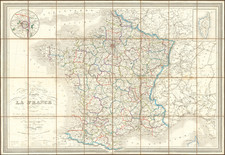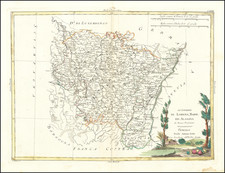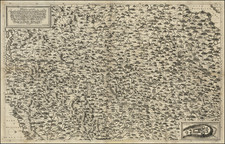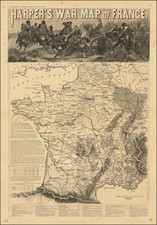Rare “BIGOT”-rated planning map for the D-Day landing at Utah Beach.
A rare composite photographic map prepared for the D-Day landing at Utah Beach, bearing the very rare and ultra-secret “BIGOT” classification. With provenance to the aide-de-camp to U.S. Army Major General Harold W. Blakely (1893-1966), commander of the 4th Infantry Division during Operation Overlord.
“… nothing was more secret—or more vital to Operation Neptune—than the mosaic of Allied intelligence reports that cartographers and artists transformed into the multihued and multilayered BIGOT maps.” (Thomas B. Allen, “Untold Stories of D-Day,” National Geographic Magazine, June 2002, vol. 201, no. 6, p. 15)
The original plan for Operation Overlord called for three Allied divisions to land in Normandy along a 25-mile front, but at the insistence of Eisenhower and Montgomery the scope was expanded to include five divisions landing along a 50-mile front. The revised plan included a landing at what is now known as Utah Beach, on the east side of the Cotentin Peninsula, so that Allied forces could drive west and north to capture the critical port at Cherbourg. The main force assigned to the landing at Utah was the American 4th Infantry Division, supported armor from the 70th Tank Battalion and airborne strikes inland by elements of the 82nd and 101st Divisions.
Offered here is a remarkable photographic composite map assembled from dozens, possibly hundreds, of aerial photographs of the landing beach and the surrounding countryside. These would have been made by Allied reconnaissance aircraft in the months prior to the invasion, during which time they had substantial air superiority over Luftwaffe.
The map depicts some three and a half miles of beach along the east side of the Cotentin Peninsula and extends some two and quarter miles inland. The planned landing zone—“Tare Green” and “Uncle Red”—is clearly marked. The small villages La Madeline, Le Mesnilde and La Pecherie are labeled just beyond the landing beach, with the larger towns of Veaugoubert, St. Martin de Vareville, Audouville la Hubert and Ste. Marie du Mont identified at the top edge. To deter invasion, the Germans had flooded miles of farmland behind the beach, and these areas appear darker in the image. Running through the flooded areas three white slashes delineate causeways extending inland from the beach, and on June 6th these became key lines of advance for the 4th Division. The limitation notice “Copy No. 19 of 3000” appears at far lower right.
In the end, strong currents swept the first wave of the 4th Division’s landing craft some 2000 yards south of the planned landing zone, and they came ashore in the vicinity of La Grande Dune, the village at far lower left on the map (A comparison of the planned and actual landing sites can be viewed here.) The Division’s second-in-command, Brigadier General Theodore Roosevelt, Jr., determined that this spot was, in fact, better than the planned location up the beach, and the successive waves of troops were directed to come ashore there.
Though it did not achieve all of its objectives for Day One, the landing at Utah was overall a great success: The 4th suffered relatively few casualties during the landing, gained control of the beach within just a few hours, and by the end of the day had penetrated several miles inland.
The BIGOT classification
The lower-right corner of the map bears the label “TOP SECRET – BIGOT. UNTIL LOADED ON CRAFT THEREAFTER “RESTRICTED.” Introduced during the Second World War, BIGOT was the highest-level military security classification, above Top Secret. Some sources suggest that it was an acronym for “British Invasion of German Occupied Territory;” others, that it was a “backronym” for “To Gib,” the code stamped on the papers of officers headed to Gibraltar in advance of the 1942 North Africa invasion.
Whatever the origins of the term, extraordinary efforts were made to protect BIGOT-level material. When for example a practice landing (“Operation Tiger”) on the Devon coast was ambushed by U-Boats, Eisenhower himself ordered the recovery of the bodies of the ten known victims with BIGOT clearance. This was necessary to prove that they had not been captured alive, as their capture would have compromised the invasion plans and necessitated its cancellation.
Provenance
Until recently, the map was in the possession of the stepson of Capt. Roswell F. MacGillivray, aide-de-camp to Major General Harold W. Blakely, commander of the 4th Division. Among MacGillivray’s duties during the Normandy Campaign was to perform reconnaissance and target spotting for the 4th Division Artillery, which landed on Utah Beach with the bulk of the 4th Division on June 6, 1944, and it is highly likely that he consulted this and other maps offered in this sale in the course of these missions. Present with the map are photocopies of several documents related to MacGillivray's service in the 4th.
In all, a rare and richly-informative artifact from one of the most significant, dramatic and terrifying events in American military history.
Owned in partnership with Boston Rare Maps.









![[Set of 5 D-Day Maps of Normandy] Les Pieux Guernsey, Cherbourg-Valognes, Avranches-Fougeres, St.-Lô-Vire, Caen-Falaise](https://storage.googleapis.com/raremaps/img/small/93936.jpg)



![(Geological Map of France) Carte Geologique de la France [4 sheets]](https://storage.googleapis.com/raremaps/img/small/93799.jpg)
